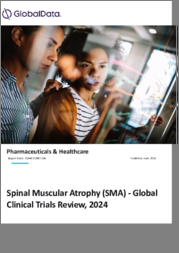
|
시장보고서
상품코드
1573863
척수성 근위축증(SMA) 치료 시장, 기회, 성장 촉진요인, 산업 동향 분석 및 예측(2024-2032년)Spinal Muscular Atrophy Treatment Market, Opportunity, Growth Drivers, Industry Trend Analysis and Forecast, 2024-2032 |
||||||
세계 척수성 근위축증(SMA) 치료 시장은 73억 달러 규모로 2024년부터 2032년까지 연평균 19.1%의 성장률을 보일 것으로 예상됩니다.
주요 촉진요인으로는 신생아 검진 프로그램의 확대로 조기 진단과 치료 적격성 향상으로 이어지는 신생아 검진 프로그램의 확대가 꼽힙니다. Health Union, LLC의 보고에 따르면 SMA는 전 세계 신생아 6,000-10,000명당 1명꼴로 발병하며, 1형 SMA가 가장 심각하고 전체 사례의 절반 이상을 차지합니다. 현재 약 25,000명의 미국인이 SMA를 앓고 있습니다. 진단 기술의 발전과 의료진과 환자의 인식 개선이 시장 성장의 원동력이 될 것으로 예상됩니다.
세계 SMA 치료 시장은 유형별로 유아 SMA, Werdnig-Hoffmann병, 성인 SMA, Kugelberg-Welander병으로 구분되며, Werdnig-Hoffmann병 분야는 2023년 29억 달러로 시장을 주도하고 있습니다. 신생아 검진 의무화로 조기 발견이 용이해져 운동 뉴런이 심각하게 손실되기 전에 가장 효과적인 치료를 신속하게 시행할 수 있게 됐습니다. 이러한 추세는 시장 성장의 원동력이 될 것으로 보입니다. 연구 개발은 치료비 절감을 위한 제약사와의 제휴와 함께 환자 접근성을 확대하여 시장 성장을 더욱 촉진하고 있으며, SMA1형 치료를 위한 조기 접근 프로그램 및 컴패니언 사용 프로그램도 시장 성장의 모멘텀을 강화하고 있습니다.
치료 유형별로는 약물요법, 지지요법, 척수 수술이 있습니다. 안티센스 올리고뉴클레오티드, 유전자 치료 및 기타 약물을 포함한 약물 치료 분야는 2023년 64.2%의 점유율을 차지했으며, Spinraza(Nusinersen)와 Evrysdi(Risdiplam)와 같은 혁신적인 치료제는 유전적 근원을 표적으로 삼고 SMN 단백질 생산을 강화함으로써 SMA 치료의 판도를 바꾸며 시장 성장을 주도하고 있습니다. 주사제와 경구용 약물이 모두 출시되면서 치료 접근성이 향상되고 다양한 환자들의 니즈와 선호도를 충족시킬 수 있게 되어 시장 성장에 박차를 가하고 있습니다.
북미, 특히 미국은 2023년 전 세계 SMA 치료 시장에서 45.6%의 큰 점유율을 차지했으며, 향후에도 그 우위를 유지할 것으로 전망됩니다. 희귀질환에 대한 지원 정책, 첨단 의료 시설, 진행 중인 임상시험이 이 지역의 시장 성장을 촉진하는 주요 요인입니다. 또한, 주요 제약사의 존재와 R&D 자금의 증가는 시장을 더욱 강화시키고 있습니다. 척수성 근위축증에 대한 인식 개선과 조기 진단도 치료 환경 확대에 기여하고 있습니다.
목차
제1장 조사 방법과 조사 범위
제2장 주요 요약
제3장 업계 인사이트
- 생태계 분석
- 업계에 대한 영향요인
- 성장 촉진요인
- 유아 및 소아의 척수성 근위축증 진단율 증가
- 유전자 치료의 진보
- 의료 제공자에 의한 인지도 향상과 스크리닝 프로그램
- 업계의 잠재적 리스크와 과제
- 신규 치료에 대한 규제 당국의 엄격한 승인
- 치료비 급등
- 성장 촉진요인
- 성장 가능성 분석
- 규제 상황
- 향후 시장 동향
- 파이프라인 분석
- Porters 분석
- PESTEL 분석
제4장 경쟁 상황
- 소개
- 기업 점유율 분석
- 기업 매트릭스 분석
- 주요 시장 기업의 경쟁 분석
- 경쟁 포지셔닝 매트릭스
- 전략 대시보드
제5장 시장 추정과 예측 : 유형별, 2021-2032년
- 주요 동향
- 베르드니히-호프만병
- 유아 SMA
- 쿠겔베르그-웰란더병
- 성인 SMA
제6장 시장 추정과 예측 : 치료 유형별, 2021-2032년
- 주요 동향
- 약물요법
- 유전자 치료
- 안티센스 올리고뉴클레오티드
- 기타 약물요법
- 지지요법
- 물리치료
- 호흡기 서포트
- 영양 서포트
- 척추 수술
제7장 시장 추정과 예측 : 투여 경로별, 2021-2032년
- 주요 동향
- 경구
- 비경구
제8장 시장 추정과 예측 : 최종 용도별, 2021-2032년
- 주요 동향
- 병원
- 전문 클리닉
- 재택의료 현장
- 기타 최종사용자
제9장 시장 추정과 예측 : 지역별, 2021-2032년
- 주요 동향
- 북미
- 미국
- 캐나다
- 유럽
- 독일
- 영국
- 프랑스
- 스페인
- 이탈리아
- 네덜란드
- 기타 유럽
- 아시아태평양
- 일본
- 중국
- 인도
- 호주
- 한국
- 기타 아시아태평양
- 라틴아메리카
- 브라질
- 멕시코
- 기타 라틴아메리카
- 중동 및 아프리카
- 남아프리카공화국
- 사우디아라비아
- 아랍에미리트
- 기타 중동 및 아프리카
제10장 기업 개요
- American Physical Therapy Association
- Astellas Pharma
- Beijing Jinlan Gene Technology Co., Ltd.
- Biogen Inc.
- Boston's Children Hospital
- Children's Hospital of The King's Daughters
- F. Hoffmann-La Roche Ltd.
- Hanugen Therapeutics
- Nationwide Children's Hospital
- NMD Pharma A/S
- Novartis AG
- Pfizer, Inc.
- Sanofi(Genzyme Corporation)
- Scholar Rock, Inc
The Global Spinal Muscular Atrophy (SMA) Treatments Market was valued at USD 7.3 billion and is projected to grow at a CAGR of 19.1% from 2024-2032. Key drivers include the expansion of newborn screening programs, leading to earlier diagnoses and increased treatment eligibility. Early diagnosis enhances patient outcomes and boosts demand for neurological medications. Health Union, LLC reports that SMA affects 1 in every 6,000 to 10,000 newborns globally, with Type 1 SMA being the most severe and accounting for over half of all cases. Approximately 25,000 Americans currently live with SMA. Advancements in diagnostic technologies and increased awareness among healthcare providers and patients are anticipated to drive market growth.
The overall spinal muscular atrophy treatment industry is classified based on type, treatment type, route of administration, and region.
The global SMA treatment market is segmented by type into infant SMA, Werdnig-Hoffmann disease, adult SMA, and Kugelberg-Welander disease. The Werdnig-Hoffmann disease segment led the market with USD 2.9 billion in 2023. Mandatory newborn screenings have facilitated earlier detections, enabling prompt treatments that are most effective before significant motor neuron loss. This trend is set to drive market growth. Research and development, along with pharmaceutical collaborations to reduce treatment costs, have broadened patient access, further energizing market growth. Early access or compassionate use programs for SMA Type 1 treatment also bolster market momentum.
By treatment type, the market includes medication, supportive care, and spinal surgery. The medication segment, which includes antisense oligonucleotides, gene therapy, and other drugs, dominated with a 64.2% share in 2023. Innovative drugs like Spinraza (Nusinersen) and Evrysdi (Risdiplam) have transformed SMA treatment by targeting the genetic root and enhancing SMN protein production, driving market growth. The availability of both injectable and oral formulations has increased treatment accessibility, catering to diverse patient needs and preferences, thus fueling market growth.
North America, particularly the U.S., captured a significant 45.6% share of the global SMA treatment market in 2023 and is expected to maintain its dominance. Supportive policies for rare diseases, advanced healthcare facilities, and ongoing clinical trials are key factors driving market growth in the region. Additionally, the presence of leading pharmaceutical companies and increased funding for research and development are further bolstering the market. Rising awareness and early diagnosis of spinal muscular atrophy are also contributing to the expanding treatment landscape.
Table of Contents
Chapter 1 Methodology and Scope
- 1.1 Market scope and definitions
- 1.2 Research design
- 1.2.1 Research approach
- 1.2.2 Data collection methods
- 1.3 Base estimates and calculations
- 1.3.1 Base year calculation
- 1.3.2 Key trends for market estimation
- 1.4 Forecast model
- 1.5 Primary research and validation
- 1.5.1 Primary sources
- 1.5.2 Data mining sources
Chapter 2 Executive Summary
- 2.1 Industry 360°synopsis
Chapter 3 Industry Insights
- 3.1 Industry ecosystem analysis
- 3.2 Industry impact forces
- 3.2.1 Growth drivers
- 3.2.1.1 Increase in diagnosis rate of spinal muscular atrophy in infants and children
- 3.2.1.2 Advancement in gene therapy
- 3.2.1.3 Growing awareness and screening programs by healthcare providers
- 3.2.2 Industry pitfalls and challenges
- 3.2.2.1 Stringent regulatory approval for new treatments
- 3.2.2.2 High cost of treatment
- 3.2.1 Growth drivers
- 3.3 Growth potential analysis
- 3.4 Regulatory landscape
- 3.5 Future market trends
- 3.6 Pipeline analysis
- 3.7 Porter's analysis
- 3.8 PESTEL analysis
Chapter 4 Competitive Landscape, 2023
- 4.1 Introduction
- 4.2 Company market share analysis
- 4.3 Company matrix analysis
- 4.4 Competitive analysis of major market players
- 4.5 Competitive positioning matrix
- 4.6 Strategic dashboard
Chapter 5 Market Estimates and Forecast, By Type, 2021 - 2032 ($ Mn)
- 5.1 Key trends
- 5.2 Werdnig-Hoffmann disease
- 5.3 Infant SMA
- 5.4 Kugelberg-Welander disease
- 5.5 Adult SMA
Chapter 6 Market Estimates and Forecast, By Treatment Type, 2021 - 2032 ($ Mn)
- 6.1 Key trends
- 6.2 Medication
- 6.2.1 Gene therapy
- 6.2.2 Antisense oligonucleotide
- 6.2.3 Other medications
- 6.3 Supportive care
- 6.3.1 Physical therapy
- 6.3.2 Respiratory support
- 6.3.3 Nutritional support
- 6.4 Spinal surgery
Chapter 7 Market Estimates and Forecast, By Route of Administration, 2021 - 2032 ($ Mn)
- 7.1 Key trends
- 7.2 Oral
- 7.3 Parenteral
Chapter 8 Market Estimates and Forecast, By End-Use, 2021 - 2032 ($ Mn)
- 8.1 Key trends
- 8.2 Hospitals
- 8.3 Specialty clinics
- 8.4 Homecare settings
- 8.5 Other end-users
Chapter 9 Market Estimates and Forecast, By Region, 2021 - 2032 ($ Mn)
- 9.1 Key trends
- 9.2 North America
- 9.2.1 U.S.
- 9.2.2 Canada
- 9.3 Europe
- 9.3.1 Germany
- 9.3.2 UK
- 9.3.3 France
- 9.3.4 Spain
- 9.3.5 Italy
- 9.3.6 Netherlands
- 9.3.7 Rest of Europe
- 9.4 Asia Pacific
- 9.4.1 Japan
- 9.4.2 China
- 9.4.3 India
- 9.4.4 Australia
- 9.4.5 South Korea
- 9.4.6 Rest of Asia Pacific
- 9.5 Latin America
- 9.5.1 Brazil
- 9.5.2 Mexico
- 9.5.3 Rest of Latin America
- 9.6 Middle East and Africa
- 9.6.1 South Africa
- 9.6.2 Saudi Arabia
- 9.6.3 UAE
- 9.6.4 Rest of Middle East and Africa
Chapter 10 Company Profiles
- 10.1 American Physical Therapy Association
- 10.2 Astellas Pharma
- 10.3 Beijing Jinlan Gene Technology Co., Ltd.
- 10.4 Biogen Inc.
- 10.5 Boston's Children Hospital
- 10.6 Children's Hospital of The King's Daughters
- 10.7 F. Hoffmann-La Roche Ltd.
- 10.8 Hanugen Therapeutics
- 10.9 Nationwide Children's Hospital
- 10.10 NMD Pharma A/S
- 10.11 Novartis AG
- 10.12 Pfizer, Inc.
- 10.13 Sanofi (Genzyme Corporation)
- 10.14 Scholar Rock, Inc
















